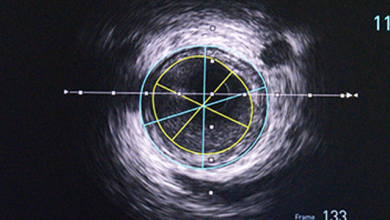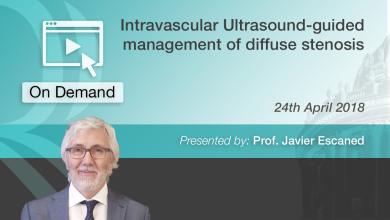Search results
Author(s):
Philip Dingli
,
Nieves Gonzalo
,
Javier Escaned
Added:
3 years ago
Diffuse Coronary Stenosis
A diffuse coronary stenosis is customarily defined as any stenosis exceeding 20 mm in length in the American College of Cardiology Foundation/American Heart Association Task Force on Practice Guidelines and the Society for Cardiovascular Angiography and Interventions (ACCF/AHA/SCAI) guidelines for PCI.6 This cut-off value has not been used in trials of diffuse…
View more
Author(s):
Andres Vasquez
,
Neville Mistry
,
Jasvindar Singh
Added:
3 years ago
Introduction
Intravascular ultrasound (IVUS) has enhanced our understanding of atherosclerotic plaque morphology, and provides a unique opportunity to guide cardiovascular interventions and evaluate the results of these interventions. IVUS is safe, cost efficient and effective in guiding clinical decisions and cardiovascular interventions and improves outcomes when used during coronary artery…
View more
Author(s):
Andrew SP Sharp
Added:
3 years ago
Introduction
Intravascular ultrasound (IVUS) can resolve abnormalities within the coronary artery to a degree that is not possible with angiography alone. With an axial resolution of 70-200 μm and lateral resolution of 200-400 μm, IVUS can provide information on arterial wall and luminal composition that can change clinical management decisions.
This document describes scenarios of clinical…
View more
Author(s):
Andrejs Erglis
,
Sanda Jegere
,
Inga Narbute
Added:
3 years ago
Intravascular ultrasound (IVUS) is the first catheter-based imaging modality that has been widely used in interventional cardiology.1 It creates cross-sectional images of the vessel lumen and the arterial wall and provides valuable diagnostic information to angiography regarding lumen and vessel measurements and plaque morphology. This information helps clinical decision-making in ambiguous…
View more
Role of IVUS in Complex PCI
Author(s):
Brandon Quintana
,
Akram Ibrahim
Added:
3 years ago
Article
Author(s):
Javier Escaned
Added:
5 years ago
Diffuse stenoses present a unique set of challenges related to accurate vessel sizing in the setting of remodelling, the identification of disease in segments that appear angiographically normal and achievement of optimal stent implantation both in terms of luminal dimensions and stent apposition.
As the absence of a well-defined workflow has likely hampered more widespread uptake of…
View more
Author(s):
Steven P Marso
Added:
3 years ago
Adiponectin (also known as APM1, Acrp 30, AdipoQ or GBP28) is a 30kD circulating plasma protein and is the most abundant adipokine secreted by adipose tissue. In humans, adiponectin accounts for approximately 0.01% of circulating plasma proteins.1 It is thought to have a unique spectrum of properties for an adipokine, many of which are anti-atherosclerotic, and is downregulated in the presence of…
View more
Author(s):
Gerald S Werner
Added:
3 years ago
Introduction
A chronic total occlusion (CTO) is defied as a 100 % occlusion in a coronary artery with Thrombolysis In Myocardial Infarction flw 0 (no antegrade flw beyond point of occlusion) and occlusion duration of >3 months. CTOs are found about 20 % of patients with coronary artery disease1 and their presence often excludes patients from undergoing percutaneous coronary intervention (PCI)…
View more













